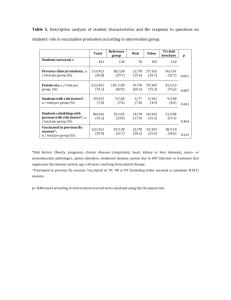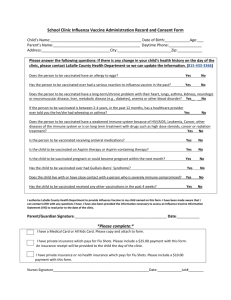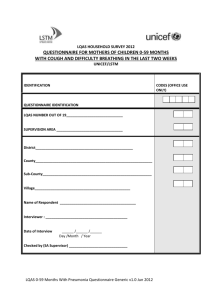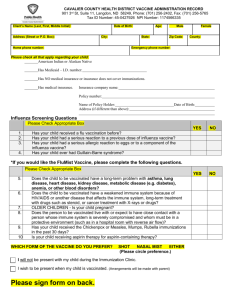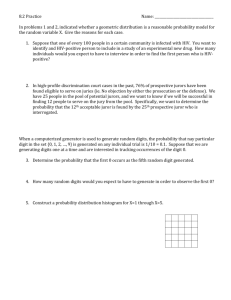Lot quality assurance sampling
advertisement
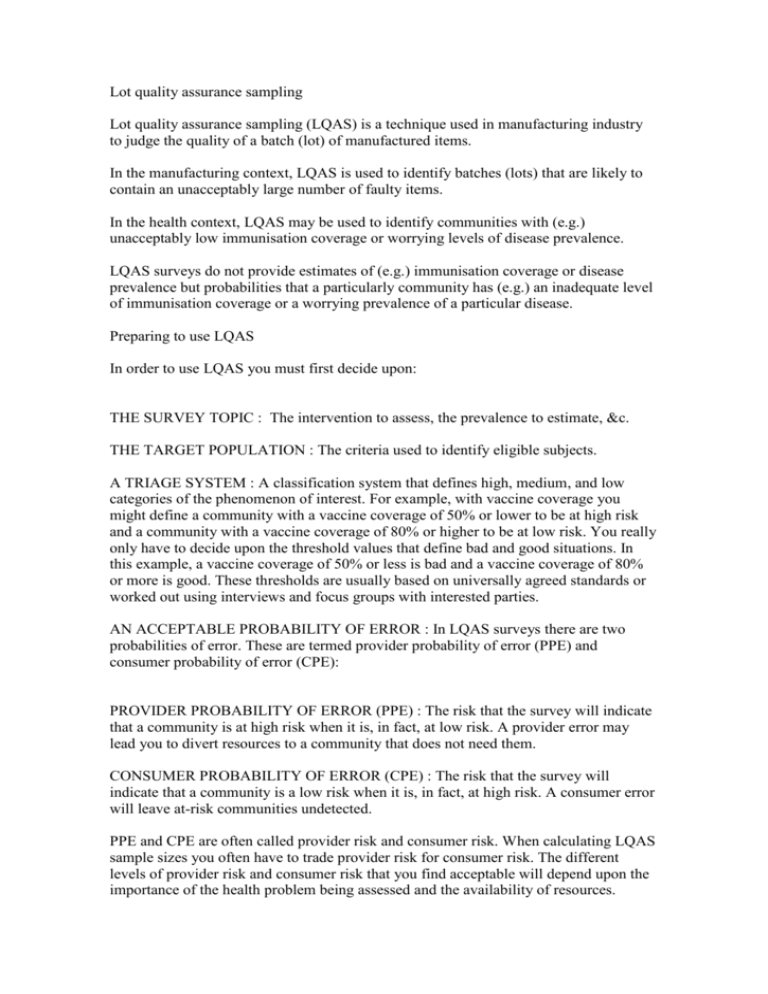
Lot quality assurance sampling Lot quality assurance sampling (LQAS) is a technique used in manufacturing industry to judge the quality of a batch (lot) of manufactured items. In the manufacturing context, LQAS is used to identify batches (lots) that are likely to contain an unacceptably large number of faulty items. In the health context, LQAS may be used to identify communities with (e.g.) unacceptably low immunisation coverage or worrying levels of disease prevalence. LQAS surveys do not provide estimates of (e.g.) immunisation coverage or disease prevalence but probabilities that a particularly community has (e.g.) an inadequate level of immunisation coverage or a worrying prevalence of a particular disease. Preparing to use LQAS In order to use LQAS you must first decide upon: THE SURVEY TOPIC : The intervention to assess, the prevalence to estimate, &c. THE TARGET POPULATION : The criteria used to identify eligible subjects. A TRIAGE SYSTEM : A classification system that defines high, medium, and low categories of the phenomenon of interest. For example, with vaccine coverage you might define a community with a vaccine coverage of 50% or lower to be at high risk and a community with a vaccine coverage of 80% or higher to be at low risk. You really only have to decide upon the threshold values that define bad and good situations. In this example, a vaccine coverage of 50% or less is bad and a vaccine coverage of 80% or more is good. These thresholds are usually based on universally agreed standards or worked out using interviews and focus groups with interested parties. AN ACCEPTABLE PROBABILITY OF ERROR : In LQAS surveys there are two probabilities of error. These are termed provider probability of error (PPE) and consumer probability of error (CPE): PROVIDER PROBABILITY OF ERROR (PPE) : The risk that the survey will indicate that a community is at high risk when it is, in fact, at low risk. A provider error may lead you to divert resources to a community that does not need them. CONSUMER PROBABILITY OF ERROR (CPE) : The risk that the survey will indicate that a community is a low risk when it is, in fact, at high risk. A consumer error will leave at-risk communities undetected. PPE and CPE are often called provider risk and consumer risk. When calculating LQAS sample sizes you often have to trade provider risk for consumer risk. The different levels of provider risk and consumer risk that you find acceptable will depend upon the importance of the health problem being assessed and the availability of resources. Following these decisions a series of probability tables are constructed. SampleLQ is a simple tool that may be used to produce LQAS probability tables. Using these probability tables you can select a sample size (n) and the number of (e.g.) unvaccinated subjects (called d for defects) that are allowed in the LQAS sample of n subjects before deciding that a community is at high risk. The combination of sample size (n) and number of defects (d) form a decision rule. Such a decision rule using n = 28, d = 9 would read: In each community select 28 children up to three years old. If nine or fewer children have not been vaccinated then this community can be considered to be adequately vaccinated. The values of n and d in the decision rule depend on the threshold values used in the triage system and the acceptable levels of provider and consumer risks that have been specified. LQAS probability tables Let us imagine that we have made the following decisions: Topic Target population Triage - good Triage - bad Acceptable provider risk Acceptable consumer risk Measles vaccination Children aged <= 36 months >= 80% vaccinated <= 50% vaccinated <= 5% <= 5% The table below shows the LQAS probability table for a sample size (n) of 28 and different numbers of defects (d = 5, 6, 7, 8 …) within each sample: Probability of Probability of detecting a detecting a community with community with n d >= 80% coverage <= 50% coverage Overall error ---- ---- --------------- --------------- ------------28 5 50% 100% 50% 6 68% 100% 32% 7 82% 99% 19% 8 91% 98% 11% 9 96% 96% 8% 10 99% 91% 11% 11 100% 83% 18% 12 100% 71% 29% ---- ---- --------------- --------------- ------------Examine row in the table for n = 28 and d = 9. This row in the table corresponds to the decision rule: In each community select 28 children up to three years old. If nine or fewer children have not been vaccinated then this community can be considered to be adequately vaccinated. You could reverse this rule to read: In each community select 28 children up to three years old. If more than nine children have not been vaccinated then this community cannot be considered to be adequately vaccinated. The probability of detecting a community with 80% or better coverage with the decision rule is 96%. This means that the decision rule identifies communities with good vaccination coverage 96% of the time. The provider risk is 4% (i.e. 100% - 96%). The same decision rule also identifies communities with poor vaccination coverage 96% of the time. The consumer risk is also 4% (i.e. 100% - 96%). The overall error (8%) is the sum of the provider and consumer error and indicates that the decision rule will correctly classify communities 92% of the time. In this example we have only examined the probability table for a single sample size (n = 28). In practice we would examine the probability tables for many different sample sizes and choose one that contained a suitable decision rule. SampleLQ - A sample size calculator for LQAS surveys SampleLQ is a program that you can use to help you calculate the sample size (n) and number of defects (d) required to create a useful LQAS decision rule. In this example you will use SampleLQ to calculate a sample size (n) and number of defects (d) for an LQAS vaccine coverage survey based on the following decisions: Triage - good Triage - bad Acceptable provider risk >= 80% vaccinated <= 50% vaccinated <= 10% Acceptable consumer risk <= 5% Start SampleLQ. Enter the 80 into the data-entry box labelled Upper level (%). Enter 50 into the data-entry box labelled Lower level (%). Click the Calculate button. SampleLQ calculates (this may take some time) and displays the probability tables for the specified triage values for different sample sizes: Note that SampleLQ does not provide a single sample size figure but a set of tables that list sample sizes (Sample Size), number of defects (D), the probability of detecting ‘good’ (P:80%) and ‘bad’ communities ( P:50%), and a total error figure (Error) for each combination of Sample Size and D for the specified threshold values (P:80% and P:50%). In order to select an appropriate sample size (n) and number of defects (d) you should scroll through the tables and identify the combinations of n and d with acceptable provider and consumer risks. A pop-up menu is available once the probability tables have been calculated (right-click anywhere on the probability tables). This menu allows you to copy selected text to the Windows clipboard. Selecting an appropriate decision rule Examining the LQAS tables produced by SampleLQ, we can see that there are several combinations of n and d that we could use to construct a decision rule for the example vaccine coverage survey: Probability of Probability of detecting a detecting a community with community with n d >= 80% coverage <= 50% coverage Overall error ---- ---- --------------- --------------- ------------18 5 87% 95% 18% 20 6 91% 94% 14% 24 7 91% 97% 12% 26 8 94% 96% 10% 28 8 91% 98% 11% 9 30 96% 9 94% 96% 98% 8% 8% 10 97% 95% 7% 32 10 96% 97% 7% 34 10 94% 99% 7% 11 97% 97% 6% 12 99% 94% 7% ---- ---- --------------- --------------- ------------Check these figures using SampleLQ. The combination of n = 26 and d = 8 fits the survey requirements with a sample size that is collectable by an individual investigator in a single day. This combination of n and d would form the decision rule: In each community select 26 children up to three years old. If eight or fewer children have not been vaccinated then this community can be considered to be adequately vaccinated. How the LQAS probability tables are calculated The vaccine coverage in a population is defined as p. In this population the probability (Pa) of selecting a number (a) of vaccinated individuals in a sample of size n is: where: p q n a n-a x! = the vaccine coverage in the population = (1 - p) = sample size (n in the LQAS decision rule) = number of vaccinated persons in the sample = number of unvaccinated persons in the sample (d in the LQAS decision rule) = factorial of x (e.g. if x = 4 then x! = 4 * 3 * 2 * 1 = 24, note 0! = 1) If we assume a vaccine coverage in a population of 80%, the probability of finding none, one, two, or three unvaccinated children in a sample of 12 children from this population is: Unvaccinated in sample Probability ---------------------- -----------------------------0 0.0687 1 0.2062 2 0.2835 3 0.2362 ---------------------- -----------------------------The probability of selecting three or fewer unvaccinated children is the sum of these probabilities: 0.0687 + 0.2062 + 0.2835 + 0.2362 = 0.7946 Here is how these results are presented in SampleLQ: Sample Size : 12 ------------------D P:80% P:50% Error ------------------0 7% 100% 93% <-- 7% » 0.0687 1 27% 100% 73% <-- 27% » 0.0687 + 0.2062 2 56% 98% 46% <-- 56% » 0.0687 + 0.2062 + 0.2835 3 79% 93% 28% <-- 79% » 0.0687 + 0.2062 + 0.2835 + 0.2362 ------------------SampleLQ performs and sums these probability calculations for all combinations of n and d. SampleLQ - Program status and version history SampleLQ is public-domain software. Feel free to make copies of SampleLQ and distribute them to your friends and colleagues. Please report any errors (bugs) by e-mail to: mark@myatt.demon.co.uk A suitable reference for SampleLQ is: Myatt MA, “SampleLQ - A sample size calculator for community-based triage surveys using lot quality assurance sampling”, Brixton Health / ICEH, Llanidloes / London, UK, 2001 The following versions of SampleLQ have been released: Version Comments ------- ------------------------------------------------------1.00 16-bit (Windows 3.1x) version. Program originally written as supporting software for the Survey Design module of MSc Community Eye Health course run by the International Centre for Eye Health in the UK. Original program written in Microsoft Visual Basic v3.00. 1.10 32-bit (Windows 9x, NT, ME, 2000) version. This is an update of the original program written for the Save the Children Fund (UK), Sight Savers International, and the International Centre for Eye Health. This version written in Borland Delphi v4.00. ------- -------------------------------------------------------
